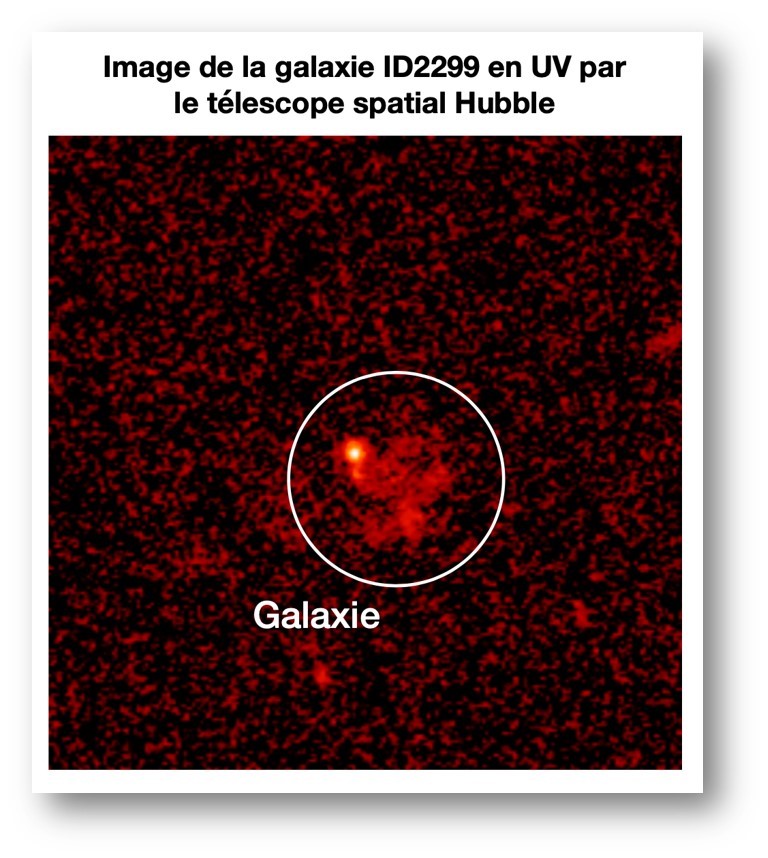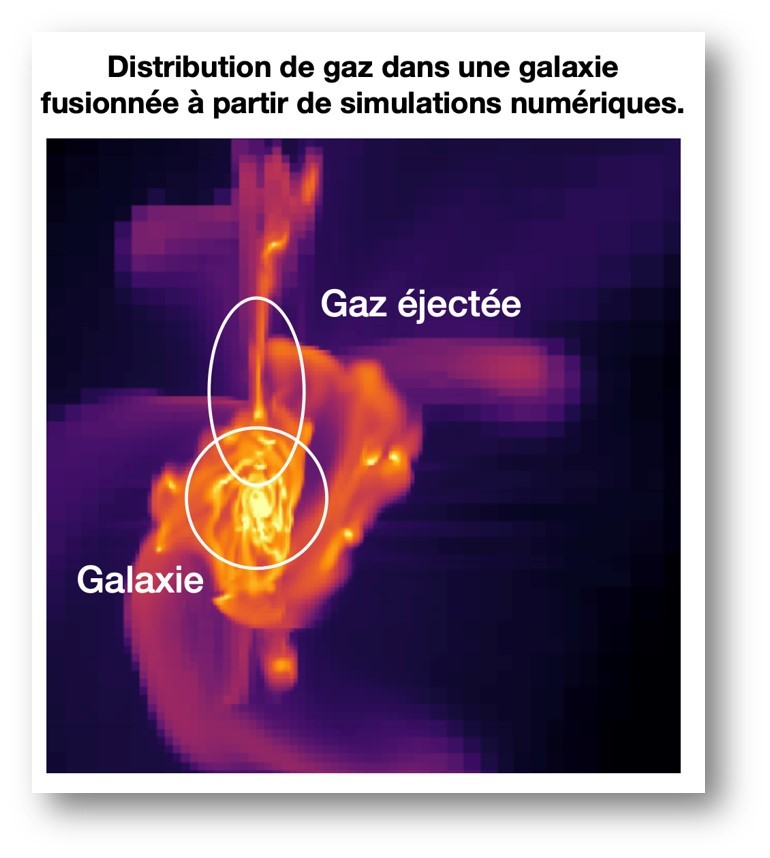
The HST (Hubble Space Telescope) image shows the light coming from young stars in galaxy ID2299. The morphology of the galaxy in this image is very disturbed as a result of the merging of galaxies that preceded it and the absorption by dust that is abundant in the merged galaxies. © Puglisi et al. 2020
The "cosmic noon", when the universe was 4 to 5 billion years old, marked a very active period of star formation for most galaxies. Paradoxically, about a third of the most massive galaxies at that time were dead and no longer forming stars. To date, the reduction in star formation activity is often attributed to gas flows caused by the feedback of supermassive black holes, but their impact on the galaxies of the young Universe has not yet been definitively established.
Thanks to the ALMA interferometer, a team of astrophysicists in which the Astrophysics Department / AIM Laboratory of CEA Paris-Saclay is strongly involved, has detected an exceptional gas ejection in a massive galaxy, called ID2299. According to their analyses the scenario of this announced death cannot come from black holes, but from the fusion of spiral galaxies which is at the origin of the galaxy. What if with this new scenario, we revisit the autopsy reports of dead galaxies... The quantitative observations of this study raise questions. The results have just been published in the journal Nature Astronomy: https://www.nature.com/articles/s41550-020-01268-x
ID2299 : a disturbed galaxy
The ejection discovered in this galaxy implies that about half of the cold gas of this galaxy is being expelled from the system and sent into the surrounding intergalactic space (see figure). At this ejection rate, the galaxy would be deprived of the material to form new stars in only a few million years, i.e. almost instantaneously with respect to cosmological time scales.
This very important gas ejection will kill the galaxy which will become a dead galaxy no longer making stars.
Understanding the mechanisms responsible for the death of galaxies
Most of the stars in the Universe today are located in large, extremely massive, spheroidal "elliptical" galaxies. These galaxies, which seem simple to describe, are among the most mysterious objects in the cosmos. Elliptical galaxies in the local Universe are made up of very old stars and no longer form new ones. Astrophysicists have long been trying to understand the mechanisms responsible for the death of these galaxies, i.e. the suppression of star formation in these systems. The discovery of the massive ejection of cold gas from the elliptical galaxy ID2299 could help scientists to better understand this phenomenon.
What is the reason for the exceptional ejection of cold gas out of the ID2299 galaxy?
In similar situations, scientists often think that super-massive black holes, found in the heart of galaxies, are responsible. The accretion activity on the black hole is capable of emitting large amounts of energy by producing winds that could sweep away the galaxy's gas, which is the material needed to form new stars. This feedback activity is an essential ingredient to reproduce galaxy observations with numerical simulations. However, the extreme nature of the case of ID2299, which loses more than half of its gas, allows to exclude with confidence this 'standard' explanation at least in this case. In fact, the huge mass of the ejected gas and the ejection rate cannot be explained by the feedback winds.

Figure 2: The image shows the distribution of cold gas in a molten galaxy through numerical simulations. © Fensch et al. 2017, Monthly Notices of the Royal Astronomical Society, Volume 465, Issue 2, p.1934-1949, doi:10.1093/mnras/stw2920
Tidal tails caused by galaxy fusion
On the other hand, this ejection can be satisfactorily explained by the formation of a tidal tail produced by the fusion between two massive galaxies, which is in progress in ID2299. The fusion of the galaxies has thus expelled a large part of the gas in an exceptional tidal tail. Because of this same fusion, the remaining half of the cold gas in ID2299 has been compressed in a dense core located at its center, a zone called "starburst". This gas remaining in ID2299 is converted into new stars very quickly, at a rate about 500 times faster than in our galaxy, and will be consumed and depleted very quickly.
This conclusion is supported by detailed simulations, for a galaxy with the characteristics of ID2299. Figure 2 opposite shows the distribution of cold gas in a molten galaxy by numerical simulations. The image corresponds to the time when the system has almost completed the merging of the two galaxies into one. The areas in yellow indicate the denser gas. The majority of the gas is in the "starburst", where new stars are forming at a fast rate. Some of the gas is ejected in a tidal tail. The configuration is similar to the state of ID2299.
Tidal tails are not exotic phenomena and are regularly observed in interacting galaxies close to us, especially in the Antenna Galaxies. It is very difficult to identify tidal tails in distant galaxies, because of their low luminosity. The tidal tail identified in ID2299 is still quite rare. This discovery was only possible thanks to a large statistical sample of cold gas emission maps in more than 100 galaxies from the 'cosmic noon' era obtained in multi-year observation projects with the ALMA interferometer located in Chile. Nevertheless, the researchers have calculated that the frequency of these events is sufficient to explain in principle most of the galaxies without star formation that formed during this period.
In conclusion, their results suggest that mergers play a central role in the evolutionary cycle of galaxies and their maturity. This study also suggests that violent ejection phenomena are not necessarily due to feedback but also to mergers. However, it is very difficult to distinguish these mechanisms, which often coexist in the same galaxy, because they may give similar observational characteristics. It is possible that several observational results published in the last decades have concluded too quickly to feedback phenomena. They will therefore have to be reconsidered in this new light.
Contacts: (Durham, UK), Emanuele Daddi (Irfu)
Find on the site of the University Paris Saclay this article popularized on the subject:
